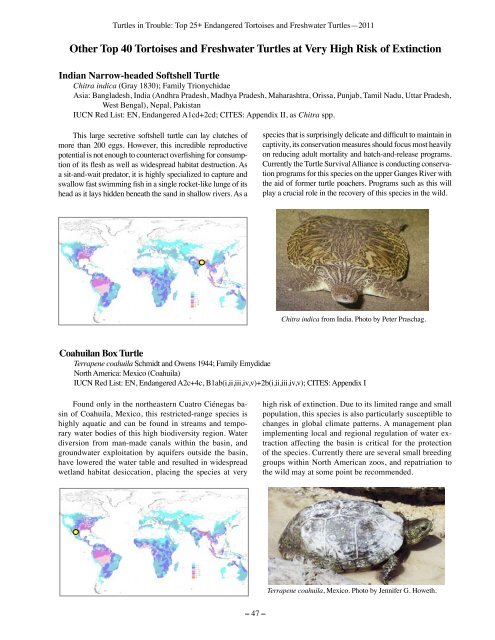Turtles in Trouble: The World's 25+ Most Endangered - Wildlife ...
Turtles in Trouble: The World's 25+ Most Endangered - Wildlife ...
Turtles in Trouble: The World's 25+ Most Endangered - Wildlife ...
- No tags were found...
Create successful ePaper yourself
Turn your PDF publications into a flip-book with our unique Google optimized e-Paper software.
<strong>Turtles</strong> <strong>in</strong> <strong>Trouble</strong>: Top <strong>25+</strong> <strong>Endangered</strong> Tortoises and Freshwater <strong>Turtles</strong>—2011Other Top 40 Tortoises and Freshwater <strong>Turtles</strong> at Very High Risk of Ext<strong>in</strong>ctionIndian Narrow-headed Softshell TurtleChitra <strong>in</strong>dica (Gray 1830); Family TrionychidaeAsia: Bangladesh, India (Andhra Pradesh, Madhya Pradesh, Maharashtra, Orissa, Punjab, Tamil Nadu, Uttar Pradesh,West Bengal), Nepal, PakistanIUCN Red List: EN, <strong>Endangered</strong> A1cd+2cd; CITES: Appendix II, as Chitra spp.This large secretive softshell turtle can lay clutches ofmore than 200 eggs. However, this <strong>in</strong>credible reproductivepotential is not enough to counteract overfish<strong>in</strong>g for consumptionof its flesh as well as widespread habitat destruction. Asa sit-and-wait predator, it is highly specialized to capture andswallow fast swimm<strong>in</strong>g fish <strong>in</strong> a s<strong>in</strong>gle rocket-like lunge of itshead as it lays hidden beneath the sand <strong>in</strong> shallow rivers. As aspecies that is surpris<strong>in</strong>gly delicate and difficult to ma<strong>in</strong>ta<strong>in</strong> <strong>in</strong>captivity, its conservation measures should focus most heavilyon reduc<strong>in</strong>g adult mortality and hatch-and-release programs.Currently the Turtle Survival Alliance is conduct<strong>in</strong>g conservationprograms for this species on the upper Ganges River withthe aid of former turtle poachers. Programs such as this willplay a crucial role <strong>in</strong> the recovery of this species <strong>in</strong> the wild.Chitra <strong>in</strong>dica from India. Photo by Peter Praschag.Coahuilan Box TurtleTerrapene coahuila Schmidt and Owens 1944; Family EmydidaeNorth America: Mexico (Coahuila)IUCN Red List: EN, <strong>Endangered</strong> A2c+4c, B1ab(i,ii,iii,iv,v)+2b(i,ii,iii,iv,v); CITES: Appendix IFound only <strong>in</strong> the northeastern Cuatro Ciénegas bas<strong>in</strong>of Coahuila, Mexico, this restricted-range species ishighly aquatic and can be found <strong>in</strong> streams and temporarywater bodies of this high biodiversity region. Waterdiversion from man-made canals with<strong>in</strong> the bas<strong>in</strong>, andgroundwater exploitation by aquifers outside the bas<strong>in</strong>,have lowered the water table and resulted <strong>in</strong> widespreadwetland habitat desiccation, plac<strong>in</strong>g the species at veryhigh risk of ext<strong>in</strong>ction. Due to its limited range and smallpopulation, this species is also particularly susceptible tochanges <strong>in</strong> global climate patterns. A management planimplement<strong>in</strong>g local and regional regulation of water extractionaffect<strong>in</strong>g the bas<strong>in</strong> is critical for the protectionof the species. Currently there are several small breed<strong>in</strong>ggroups with<strong>in</strong> North American zoos, and repatriation tothe wild may at some po<strong>in</strong>t be recommended.Terrapene coahuila, Mexico. Photo by Jennifer G. Howeth.– 47 –







![RaLand / SeaScape [PDF] - Wildlife Conservation Society](https://img.yumpu.com/49974326/1/190x245/raland-seascape-pdf-wildlife-conservation-society.jpg?quality=85)








